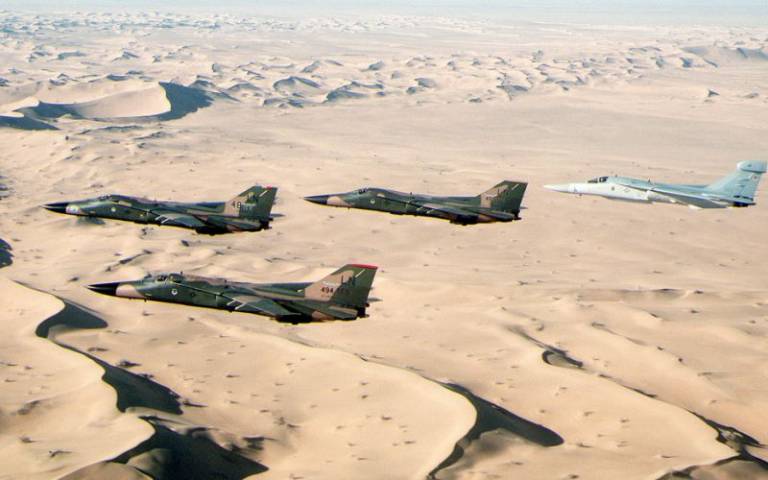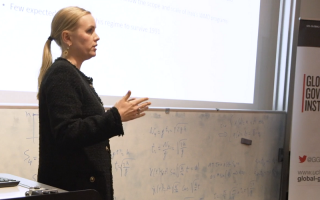Cheater’s Dilemma – Disarming Iraq after the Gulf War
4 January 2019
Zareen Aslam (MSc Global Governance and Ethics) on a GGI keynote lecture with Dr Målfrid Braut-Hegghammer.

States often pursue secret initiatives and, on occasion, they get caught. Once caught, they have a dilemma: how much should they admit?
In the case of Iraq, Saddam Hussein’s regime faced the 'Cheaters Dilemma' after the second Gulf War, in the early 1990s. At that time, the international community was aware that Iraq had developed weapons of mass destruction (WMD), however, the full scale and scope of its past programmes had not yet come to light. It became clear to UN weapons inspectors that Iraq was withholding important information. Iraq faced a dilemma: Should it admit to everything, including past indiscretions, or limit disclosure to just the information that had already become public? The Iraqi regime debated these choices at great length.*
The harshest repercussions of Iraq’s confused and misleading response to this dilemma would not be felt until 2003, when the US/UK-led alliance waged a 'War on Terror' in Iraq, in retaliation for the 9/11 attacks in New York and Washington. 'Concerns' about Iraqi WMD were cited as justification for the bombing, despite Iraq’s complete disarmament almost 5 years earlier. This article sheds light on why this happened, drawing on a recent GGI keynote lecture with Dr Målfrid Braut-Hegghammer, Associate Professor of Political Science at the University of Oslo. On a personal level, her talk sparked my interest as I remember well the horrors of the Gulf War and participated in mass protests against the subsequent 'War on Terror' in 2003.
The End of the Gulf War (1991)
Rewind to the end of the Gulf War in 1991 and Iraq’s acceptance of the UN Security Council Ceasefire Resolution 687. This included Iraq’s obligation to disarm of WMD 'in a complete and verifiable manner'. Iraq’s compliance was required for comprehensive economic sanctions to be lifted. However, there was a contentious clause: the UN Security Council had to authorise the lifting of these sanctions once disarmament was verified. This clearly weakened Iraq’s incentive to cooperate, because even if it disarmed fully, there was no guarantee that the sanctions, which were having devastating effects on the Iraqi people, would ever be lifted.
Disarmament Period (1991-1998)
This was a period of increasingly mixed signals from the Iraqi regime. Differing opinions on how to handle the disclosure at the top level of the administration, as well as the surprising defection of Hussain Kamal, mastermind of Iraq’s military operations, to Jordan, partially explain this confusion. Some of those involved stated that Iraq would say one thing to the UN inspectors, suggesting the WMD stockpiles had been destroyed, whilst implying to others that they had not complied. It was wholly unclear to the outside world if Iraq had indeed disarmed of its WMD.
It is entirely possible that Iraqi officials were behaving this way to avoid 'losing face' with other Arab nations for bowing down to US demands. It has also been argued that the Iraqi regime was so dysfunctional that many senior officials were not aware that they had WMD.
We now know that, despite the disincentive within the UN resolution, most of Iraq’s WMD were destroyed in 1991 and production programmes were dismantled soon after. However, many countries simply did not believe Iraq’s assurances on compliance. What was Iraq doing and saying which made these countries so suspicious and sceptical?
Braut-Hegghammer argued that Iraqi officials failed to convince UN weapons inspectors of compliance because they faced a 'Cheaters Dilemma'. If they admitted to past infringes, they would also have to admit to the embarrassment of covering up this information. This would prove damaging for Iraq’s standing in the international community, but the longer they covered up the information, the more risky it became for the regime to come clean. The Iraqi regime knew the international community had doubts about their compliance, but instead of admitting to everything, they decided to continue muddling through until the international community’s attention was diverted. This strategy worked to a large extent until 9/11.
Consequences for Iraq
Once lies were revealed, Iraq’s credibility continued to be undermined. There were many situations where Iraqi officials could have come clean, but fear of the brutal Iraqi regime prevented their cooperation. Braut-Hegghammer argued that the Cheater’s Dilemma shifted reputational costs from the Iraqi state to actors inside the state, i.e. the scientists and officials responsible for the cover-up. The interviews with these individuals showed that that their personal risks were more salient than the regime risks in influencing their behaviours. These risks systematically impeded longer term benefits of convincing other states of compliance and admitting all past indiscretions.
The consequences for Iraq became more poignant in October 1991, when the CIA made a disturbing assessment of Iraq’s behaviour which stated that the non-compliance with the UN Security Council resolutions 687 and 707 "is driven more by a desire to preserve future options [to complete its nuclear weapons programme] than it is by a fear of revealing past indiscretions". This assessment may have sealed Iraq’s fate in 2003, when George W. Bush and Tony Blair hunted for a scapegoat for the 9/11 terrorist attacks. Contrary to the CIA assessment, the primary sources available to Braut-Hegghammer revealed clearly that Iraq was, absolutely, worried about revealing past indiscretions and less about the future of its WMD programmes.
Lessons Learned
Reflecting on these events leaves one with a million questions about how the consequences could have been prevented, especially when assessing the human cost of the decisions/blunders made by Iraq, the UN Security Council and the international community. However, the insights brought to light by Braut-Hegghammer suggest that there are lessons to be learned.
The UN Security Council resolutions must not be weakened by flawed incentives and additional hurdles where the compliance of weaponised states is required. Thus, the UN should be wary of demanding full historical disclosure of past WMD programmes as this introduces new risks, making the verification process difficult. For example, the 2015 Iran nuclear deal focussed on verifying compliance through capabilities rather than demanding a full historical account of the Iranian nuclear weapons programmes.
Conclusion
Iraq failed to take extra steps to demonstrate compliance, possibly to avoid humiliation for prostrating themselves to the West in front of regional and domestic audiences. The oppressive regime instilled fear in scientists and officials, rendering them reluctant to co-operate honestly with UN weapons inspectors. The mixed messages and signals made the international community suspicious that Iraq remained active in the production of WMD. This was confirmed by the CIA and their 1991 assessment may have been a factor in the justification of the US/UK-led war in Iraq in 2003.
The research presented by Braut-Hegghammer was fascinating and has broad implications for future negotiations with weaponised states. However, the subject matter rekindled past frustrations: What evidence did the United States have that linked the 9/11 bombers with Iraq in the first place? Why was Iraq bombed into the dark ages with almost half a million Iraqi civilians dead since 2003 without this evidence?** Finally, why has the International Criminal Court (ICC) failed to indict any of the main players for war crimes, for one of the greatest injustices of our time?
*CRRC Archives: Dr Braut-Hegghammer was able to research the Iraqi narrative by using unique primary sources from inside the Iraqi regime itself. These sources permitted her to step inside the debates, discussions and internal confusion that the Iraqi regime was embroiled in during the 1990’s disarmament period. Included in these sources are interviews with, and personal papers of, senior Iraqi nuclear scientists, senior Iraqi officials, UN Inspectors as well as other captured documents now held in the United States. These invaluable sources shed new light on what was going on inside the minds and hearts of the Iraqi government and UN weapons inspectors.
**Hagopian, A, Flaxman AD, Takaro TK, Esa Al Shatari SA, Rajaratnam J, Becker S, Levin-Rector A, Galway L, Hadi Al-Yasseri BJ, Weiss WM, Murray CJ, Burnham G. Mortality in Iraq associated with the 2003-2011 war and occupation: Findings from a national cluster sample survey by the University Collaborative Iraq Mortality Study. PLOS Medicine. 2013 Oct; (10)10: e1001533. DOI:10.1371/journal.pmed.1001533.
 Close
Close


